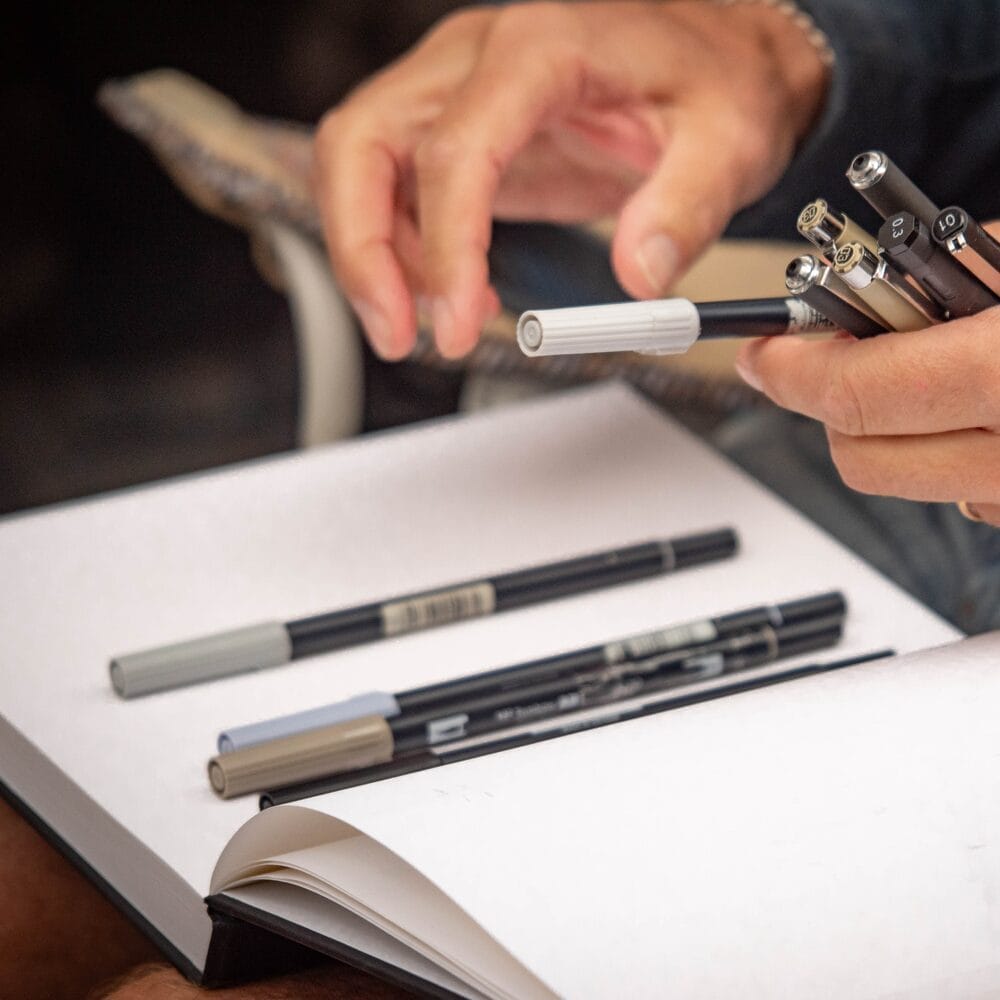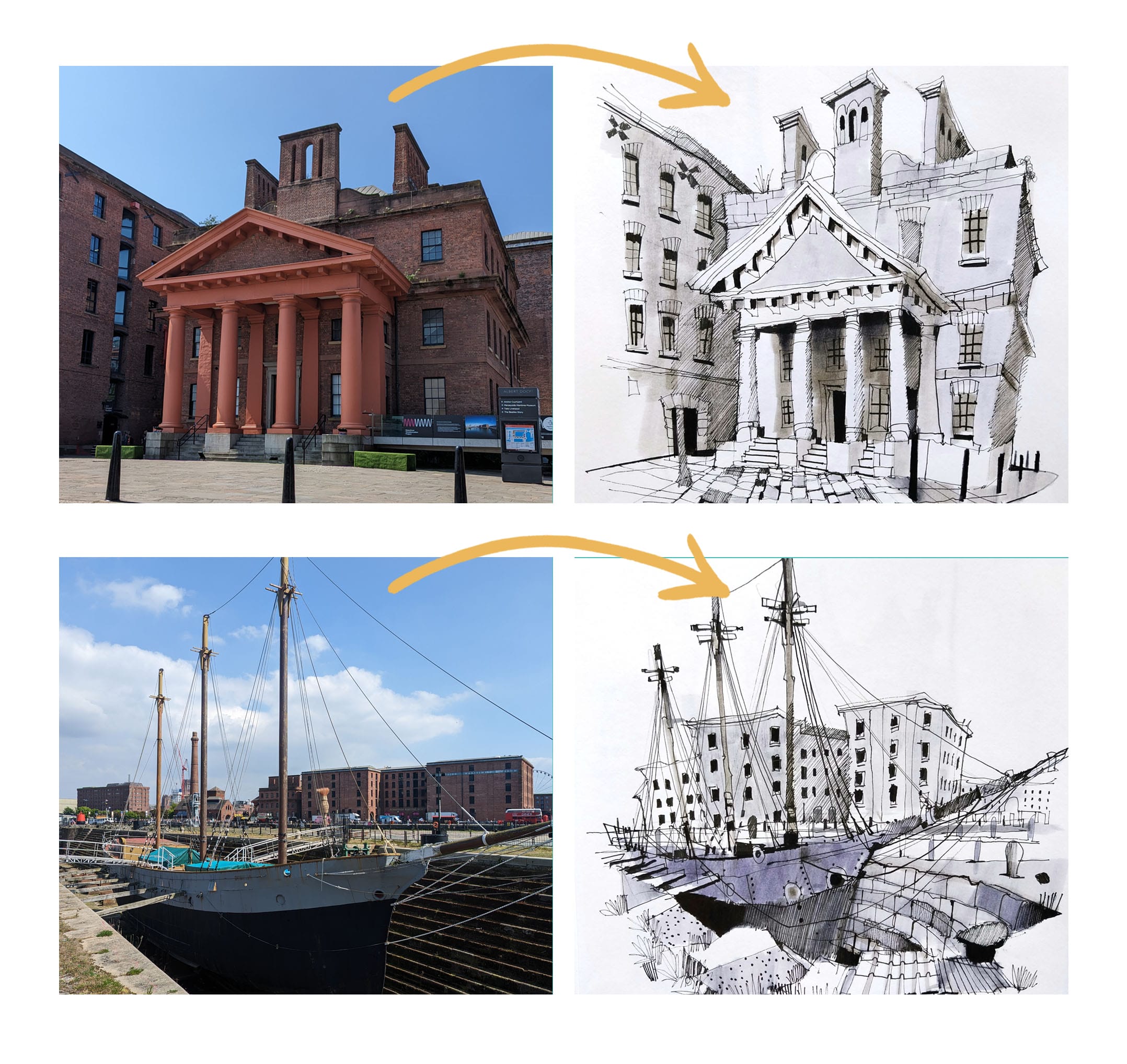How to Draw Faster: 5 tips for sketching quickly
Sketching quickly is an invaluable skill for artists, enabling the capture of fleeting ideas, thoughts, and inspirations and recording the essence of a location or subject.
Whether it’s during your lunch break or waiting for your next appointment, there are many ways to seize brief moments and transform fleeting minutes into beautiful sketches.
In this blog post, we delve into some top tips from Ian Fennelly’s Quick Sketch Course to help you loosen up and give your sketching a speed boost.
1. CONSIDERING MATERIALS
Selecting the right tools is crucial for learning to sketch quickly. While personal preference plays a significant role, certain tools are particularly useful for fast sketching.
Lightweight or smaller sketchbooks and responsive drawing instruments like ink pens, and brush pens offer versatility, making them ideal choices for urban sketching and other on-the-go drawing activities.
You might also want to consider working in black and white, a technique used in the Quick Sketch Course, to help you focus on sketching quickly whilst still adding depth to your sketches using various tones.
Here are some of the materials Ian Fennelly uses when creating quick sketches:

Sketchbook
When working with watercolour, Ian uses an A3-sized paper designed specifically for colour use with a high absorbency.
However, for fast sketching, Ian prefers a smaller square multi-media sketchbook with 150gsm paper, which is perfect for capturing scenes in just pen and ink.
You might also consider using a smaller A5 or A4 size.

Pen and Ink
Markers and pens, such as alcohol-based markers or fine-tip pens, provide a great way to add lots of tonal value to your quick sketches.
They’re particularly useful for urban sketching, where you may want to work quickly and with precision.
When creating quick sketches Ian uses a range of grey Tombow brush pens, a 1mm Uniball roller pen, and a range of Staedtler Fine Liner pens, ranging from 0.1 to 0.3 in size.
These combined help to show a wide range of tone and line variety, helping to show a wide range of depth quickly.
2. Loose Lines
To master how to draw quickly, it’s worth experimenting and adopting new specific techniques to help you loosen up. Gesture drawing is a cornerstone of fast sketching, focusing on the movement and flow of the subject over intricate details.
Try experimenting by using fewer lines than you normally would and try omitting certain details to compress your sketching into shorter timeframes.
This approach will help you capture the essence of the subject with minimal lines, making it perfect for dynamic urban environments or fleeting natural scenes.
3. Speed Over Perfection
Quick sketching is as much about the process as it is about the outcome. A common barrier to learning how to sketch quickly is the fear of making mistakes.
Embracing imperfections and viewing them as integral to the character of a sketch is crucial. This mindset not only liberates you to sketch more boldly and with greater fluidity but also boosts your creativity and willingness to experiment.
Quick sketching encourages you not to overthink your work.
As you gain comfort with sketching swiftly, you’ll be less intimidated by blank pages!
4. Embracing Moments & Regular Sketching
Picture this: You’re waiting for your next appointment and manage to create your first quick sketch while waiting. Not a bad use of time, huh? Quick sketching can inspire us to find creative moments throughout our busy days, turning lunch breaks into opportunities for creativity!
Regular sketching, whether in short daily sessions or during longer, focused practice times, is crucial for improving your speed and confidence. Dedicating time to deliberate practice, such as engaging in speed challenges or focusing on specific techniques, can accelerate your progress.
Moreover, the spontaneity and practice of quick sketching can lead to the development of your unique drawing style.

“Sometimes when you’re on location, you haven’t got a huge amount of time.
The idea behind these kinds of sketches is not to do a polished and complete sketch. It’s to capture the essence, the feel, the vibrancy, and the energy of these particular places.
Quick sketching can help force you into not overthinking things and put the marks down quickly to take you in new directions.”.
– Ian Fennelly
5. Set a time limit
To practice working quickly, you’ll need to decide how much time to spend on a subject or scene. In the Quick Sketch Course, Ian allocates 30 minutes for each sketch. Even though he omits certain areas, lines, and subjects, he still captures numerous fascinating details. This may seem fast initially, but it becomes easier with practice over time.
You could also try creating sketches in as little as 5, 10, or 15 minutes and keep track of your time using a timer.
Watch some clips from the Quick Sketch Course to see how Ian produces these sketches:
Sketching quickly opens up a world of creative possibilities, allowing artists to capture the essence of their surroundings.
Want to learn more and create your own quick sketches?

